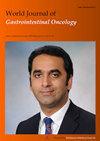缺氧诱导因子-1α的 N6-甲基腺苷修饰通过 PI3K/AKT 通路调控幽门螺旋杆菌相关性胃癌
IF 2.5
4区 医学
Q2 GASTROENTEROLOGY & HEPATOLOGY
引用次数: 0
摘要
背景幽门螺杆菌(H. pylori)定植于人类胃粘膜,与胃癌(GC)的发生有关。肿瘤微环境的特点是缺氧,其中缺氧诱导因子-1α(HIF-1α)作为转录因子发挥着关键作用,但幽门螺杆菌诱导 HIF-1α 表达和致癌的机制仍不清楚。目的 探讨幽门螺杆菌诱导的 HIF-1α 表达促进胃上皮细胞(GES-1)恶性生物学行为的内在机制。方法 该研究以体外人 GES-1 细胞为对象。通过 Western 印迹检测了甲基转移酶样蛋白 14(METTL14)、HIF-1α、PI3K/AKT 通路主要蛋白、上皮-间质转化(EMT)生物标志物和侵袭指标的相对蛋白水平。使用放线菌素 D 评估了 mRNA 的稳定性,并通过免疫荧光染色证实了 METTL14 和 HIF-1α 之间的相互作用。细胞增殖和迁移分别通过细胞计数试剂盒-8测定和伤口愈合测定进行评估。结果 幽门螺杆菌促进了 HIF-1α 的表达并激活了 PI3K/AKT 通路。值得注意的是,METTL14 在幽门螺杆菌感染的胃黏膜上皮细胞中下调,并正向调节 HIF-1α 的表达。功能实验表明,过表达 HIF-1α 或敲除 METTL14 会增强 PI3K/AKT 通路的活性,从而驱动一系列恶性转化,如 EMT 和细胞增殖、迁移和侵袭。相比之下,敲除 HIF-1α 或过表达 METTL14 则产生相反的效果。结论 幽门螺杆菌诱导的 METTL14 表达不足会促进 HIF-1α 的翻译,并通过激活 PI3K/AKT 通路加速肿瘤进展。这些结果为了解 GC 癌变提供了新的视角。本文章由计算机程序翻译,如有差异,请以英文原文为准。
N6-methyladenosine modification of hypoxia-inducible factor-1α regulates Helicobacter pylori-associated gastric cancer via the PI3K/AKT pathway
BACKGROUND
Helicobacter pylori (H. pylori ) colonizes the human gastric mucosa and is implicated in the development of gastric cancer (GC). The tumor microenvironment is characterized by hypoxia, where hypoxia-inducible factor-1α (HIF-1α) plays a key role as a transcription factor, but the mechanisms underlying H. pylori -induced HIF-1α expression and carcinogenesis remain unclear.
AIM
To explore the underlying mechanism of H. pylori -induced HIF-1α expression in promoting the malignant biological behavior of gastric epithelial cells (GES-1).
METHODS
The study was conducted with human GES-1 cells in vitro . Relative protein levels of methyltransferase-like protein 14 (METTL14), HIF-1α, main proteins of the PI3K/AKT pathway, epithelial-mesenchymal transition (EMT) biomarkers, and invasion indicators were detected by Western blot. Relative mRNA levels of METTL14 and HIF-1α were detected by quantitative reverse transcription-polymerase chain reaction. mRNA stability was evaluated using actinomycin D, and the interaction between METTL14 and HIF-1α was confirmed by immunofluorescence staining. Cell proliferation and migration were evaluated by cell counting kit-8 assay and wound healing assay, respectively.
RESULTS
H. pylori promoted HIF-1α expression and activated the PI3K/AKT pathway. Notably, METTL14 was downregulated in H. pylori -infected gastric mucosal epithelial cells and positively regulated HIF-1α expression. Functional experiments showed that the overexpression of HIF-1α or knockdown of METTL14 enhanced the activity of the PI3K/AKT pathway, thereby driving a series of malignant transformation, such as EMT and cell proliferation, migration, and invasion. By contrast, the knockdown of HIF-1α or overexpression of METTL14 had an opposite effect.
CONCLUSION
H. pylori- induced underexpression of METTL14 promotes the translation of HIF-1α and accelerates tumor progression by activating the PI3K/AKT pathway. These results provide novel insights into the carcinogenesis of GC.
求助全文
通过发布文献求助,成功后即可免费获取论文全文。
去求助
来源期刊

World Journal of Gastrointestinal Oncology
Medicine-Gastroenterology
CiteScore
4.20
自引率
3.30%
发文量
1082
期刊介绍:
The World Journal of Gastrointestinal Oncology (WJGO) is a leading academic journal devoted to reporting the latest, cutting-edge research progress and findings of basic research and clinical practice in the field of gastrointestinal oncology.
 求助内容:
求助内容: 应助结果提醒方式:
应助结果提醒方式:


